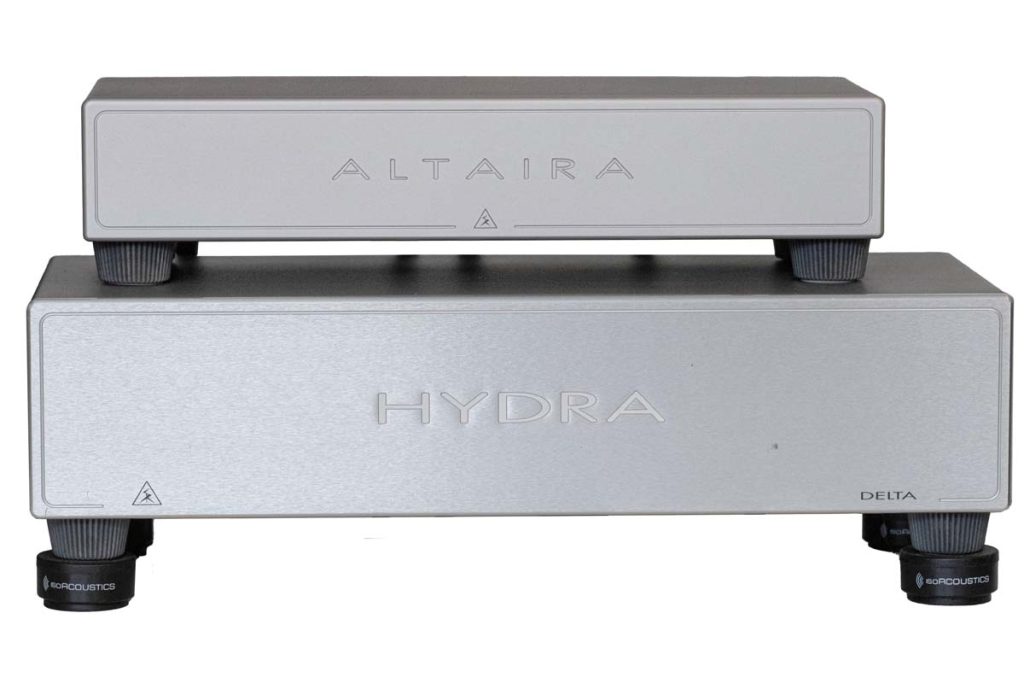A source, a DAC, an amplifier – and somewhere in between: Hum. The more complex the setup, the higher the probability of the mains current singing along. But how does this happen? And more importantly, what can we do about it? Stefan Rauch and Axel Grüning from the Munich hi-fi dealer “Rauch und Schall” share their wealth of practical experience with us.

Please note: While the technical explanations in this article are universally valid, specifics like mains voltage, amperage and frequency as well as certain design features of sockets and plugs refer to German standards and will vary depending on country.
The annoying thing about hum is that the source can be tricky to identify, as it can have different causes and also arise at different points in the system. The first thing to do, therefore, is to track the problem down to its source – which is quite easy if the hum is not coming from the speaker but directly from the amplifier’s power supply. If this is the case (and the amplifier’s power supply isn’t defective), we are dealing with so-called DC offset: Due to uneven mains loading, the alternating current can carry a direct current component that shifts the zero line between the two half-waves up or down. This imbalance gradually drives the transformer core in the amplifier into saturation, whereupon it starts to physically vibrate and thus essentially turns into a sound transducer against its will.

The hum loop
If, on the other hand, the hum comes from the loudspeakers, we may be dealing with a so-called hum loop caused by multiple earthing. Outlets often have their earthing contacts at different points and therefore also have different reference potentials. If the components of a setup draw their power from different outlets, there may be a potential difference within the “power network”. As a result, an equalizing current flows, which creeps into the signal as a low-frequency sine tone. All components of a hi-fi or home entertainment system should therefore only be supplied with power from a single socket via a mains distributor – whereby the power strip should definitely be cleared for high currents (ideally 16 amps for Germany), especially for powerful setups. This “one outlet rule” also applies to subwoofers in particular, as hum occurs at the mains frequency – typically 50 or 60 Hertz – right where the woofer feels most at home.
Never disconnect the earthing contact!
Overly smart peeps might come up with the (NOT!) bright idea of simply taping off or disconnecting the protective contacts – where there is no earthing, there can logically be no ground hum either. Dear audiophiles, do not ever even consider doing anything of that sort! I don’t even want to go into the obvious insurance trouble that you can get yourself into in this way; what’s more important is that in the event of a faulty device without earthing, the enclosure of the defective component might end up carrying the mains voltage, meaning that simply touching it could be life-threatening – no sound improvement in the world is worth such a risk!

Singling out bad actors
So everything is connected to the same socket and the humming is still there? Then it is advisable to remove all the components from the chain one by one to see if the noise disappears. If a single component can be identified as the troublemaker, you can assume that there is a fault in the power supply unit. Even though this should not really be an issue in the 21st century, it can also happen that a cheap or particularly “puristically designed” amplifier does not have a connection between the circuit ground and the protective earth via an RC combination or a pair of antiparallel diodes – in this case, double earthing and therefore a ground loop can occur in the device itself.
Hum due to interference
Hum due to interference is considered a rarity according to classical theory, but in a world full of switching power supplies, some of which are of questionable quality, it is becoming increasingly common. Due to the diminutive signal strength, anything to do with record playback is naturally particularly susceptible. However, cases where asymmetrical interconnects pick up interference from power strips are not unheard of. Fortunately, such problems can be solved very easily: Turntables, phono preamplifiers and the phono cable should be placed as far away as possible from the power amplifier, but also from other devices such as LED lamps. Otherwise, simply sensible cable management is sufficient: mains and small signal cables should be kept as separate from each other as possible, and where they have to come close to each other, they should always cross and not run parallel. With RCA connections in particular, the fault can also lie in the cable itself: As this type of connector, developed in the 1930s, is not standardized, there is always a slight variance in the exact dimensions. In extreme cases, it can happen that the jacket connection makes poor contact with the socket or even no contact at all.
With XLR cabling, the problem of interference in small signal transmission can be completely avoided. With this three-pole, balanced connection, it is not the sine waves themselves that are transmitted, but the difference between the positive and negative conductors. As any interferences are absorbed equally by both conductors, they have no influence on the difference – the subsequent circuit therefore never sees them, which is what experts call “common mode rejection”. The decisive factor here is to wire the entire chain completely symmetrically – once an RCA cable has fed interference into a component, it is “read” downstream as part of the signal from this point onwards and passed on by the interference-resistant XLR strips.
Hum and noise can also be eliminated by galvanic isolation. In the digital domain, this can be achieved using optical connections, for example, as these only transmit the signal and not the current.
Interference from Antenna connections is just as common as it is easy to eliminate. Especially where these have been retrofitted in the house, they are usually connected to their own potential and therefore cause hum. A sheath current filter (also called ground loop isolator), which uses capacitors to filter the low-frequency mains current from the signal, is a simple way of dealing with the problem. However, interference is not always so easy to detect. Stefan Rauch can report several cases in which the interference could not be reliably reproduced. In one particularly stubborn case, for example, it turned out that the source of the disturbance was an elevator that fed part of its operating energy back into the power grid through recuperation. However, as this was only ever noticeable whenever the elevator was coming to a halt, so troubleshooting was correspondingly tricky.
Mains Filters – a Panacea?
Mains power conditioning is rightly becoming an increasingly important topic in the hi-fi sector – but before investing three or four figures at random and hoping for improvement, it is definitely advisable to first eliminate the obvious sources of error as far as possible. From this basis, power conditioners can bring about further improvements and you can then be sure that you are really extracting the full sonic potential from your system.
And while we’re on the subject of hum and power conditioning, grounding solutions, such as those offered by Shunyata Research or Puritan Audio, should not go unmentioned.
Interestingly, such systems can actually achieve improvements even if there is no audible hum in the system – the mains frequency is almost always hidden somewhere in the noise floor and reduces the resolution and plasticity of the reproduction without being actively perceptible. But again, ideally, earthing systems should only be used once such a relatively hum-free state has been achieved – as an optional last mile on the way to the best possible sound.
Special thanks to Stefan Rauch and Axel Grüning from Rauch und Schall.


